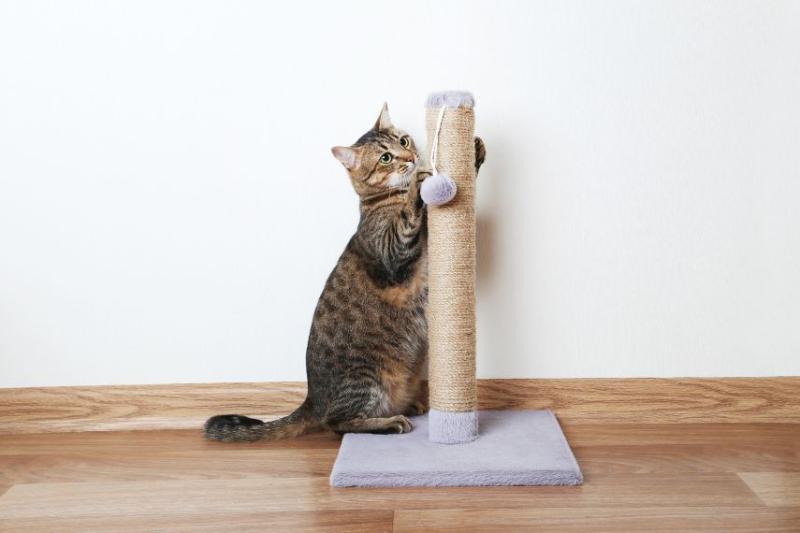
Cats love scratching, but owners often dread shredded sofas, ripped curtains and wrecked carpets.
Below, we explain how to stop your cat from pulling apart your furnishings.
Why do cats scratch?
Cats scratch for two reasons: to sharpen their claws and communicate.
A cat’s claws need to stay sharp to help them hunt. Before domestication, wild cats had to catch prey to survive, and pet cats have kept the instinct to sharpen their claws - along with other hunting behaviours such as stalking and pouncing.
Scratching allows them to remove the loose husk of the claw to reveal a new sharp claw underneath. They also benefit from a good stretch and workout, which keeps them in good shape for hunting.
Cats also have scent glands between the pads of their feet which give off a smell ‘signature’: one reason they scratch is to spread this scent and mark out their areas of territory to other cats.
How do I stop my cat scratching?
We don’t recommend preventing cats from scratching as they should be allowed to carry out normal feline behaviours, but this doesn’t mean they have to destroy your home.
Here are some scratching solutions for your home.
Appropriate scratching
Rather than trying to stop the scratching completely, redirect their attention to where you’re happy for them to do it. There are lots of scratching posts and surfaces available to buy.
The scratching post you need depends on your budget and space. They range from simple upright posts with heavy bases to elaborate tree-like structures with different levels.
If you have more than one cat, you’ll need a separate scratching post for each one; cats can become stressed when they’re forced to share resources with others.
Introducing a scratching post
At first, you’ll need to help your cat understand what to do with the scratching post. If you put it somewhere that’s convenient for you, but not somewhere your cat generally likes, they’ll probably ignore it.
Cats are naturally curious, but they’ll need to discover the post on their terms.
Put the scratching post in a place where your cat spends most of its time. For example, put it close to their bed or favourite sleeping spot, as cats generally like to scratch when they wake up.
Buying a post with catnip might make it more attractive and encourage your cat to use it. Catnip is a herb which is a mood enhancer for cats.
You could also dangle a fishing rod toy around the base for them to pounce on: once they play with one, they’ll get the idea.
How to stop your cat from scratching furniture
There are a few other things you can try:
Make your own scratching surfaces
Use offcuts of old carpets and stick these to areas your cat has been scratching using double-sided carpet tape – or wrap them around chair legs or the corners of sofas.
Set up acceptable scratching spots quickly
Once a cat has chosen a surface they like to scratch, its scent will transfer to it and it’ll keep coming back, so you need to get there first.
Apply deterrent sprays to furniture
These can smell and need to be reapplied regularly.
Wrap double-sided tape around scratching hot spots
It’ll make it unpleasant to scratch but not harmful. Make sure the tape you use is low tack so it doesn’t damage your furniture or your cat’s paws.
Fit sheets of transparent plastic over your wallpaper
You only need to do this up to the height your cat can reach. The smoothness of it should deter them from scratching and you’ll still be able to see your wallpaper through it.
Why you shouldn’t declaw
Declawing is the amputation of the last bone of each toe on a cat. It might seem a quick solution to your cat scratching your furniture, but it’s considered inhumane and will most likely cause issues with your cat.
Declawing can cause:
- chronic back pain
- paw pain
- infection
- tissue necrosis (tissue death)
- advanced arthritis
- lameness
If claws are removed improperly, they can regrow and cause nerve damage and bone spurs. Removal can also cause cats to become aggressive, as they are in pain and feel vulnerable to attack.
Is my cat is scratching because of anxiety?
There will be a few signs your cat is scratching because of anxiety, like its ears being flat against its head or tail being tucked in. Read our guide on cat body language to be able to spot the signs.
If you think your cat is anxious, there’s a few things you can do to help.
This might include changing their diet, giving them the right stimulation and exercise, or just giving them more space. Read our guide on how to treat a pet with anxiety.
Finally, never shout at or punish your cat for scratching somewhere you don’t want them to. They can’t help their instincts, and shouting will probably make them anxious.
Give them enough acceptable scratching options, as well as access to the outdoors if possible - and any damage to your home should be minimal.
I’ve spent 20 years writing about pets and exploring the wonderful relationships they have with their owners. I started as a staff writer on Dogs Today magazine, working my way up to become deputy editor in 2008. In 2010, I left the office to pursue a freelance career, relocated to north Norfolk and started a family.
Over the years I’ve contributed thoughtful human-interest features, celebrity interviews and investigative news stories to publications including The Sunday Times, Dogs Today, Dogs Monthly and Your Cat. I’ve also ghost-written veterinary books and press releases for the pet industry.
When I’m not writing, I enjoy long walks in the Norfolk countryside with my rescue lurcher Popsie. These are always followed by tea and cake.




